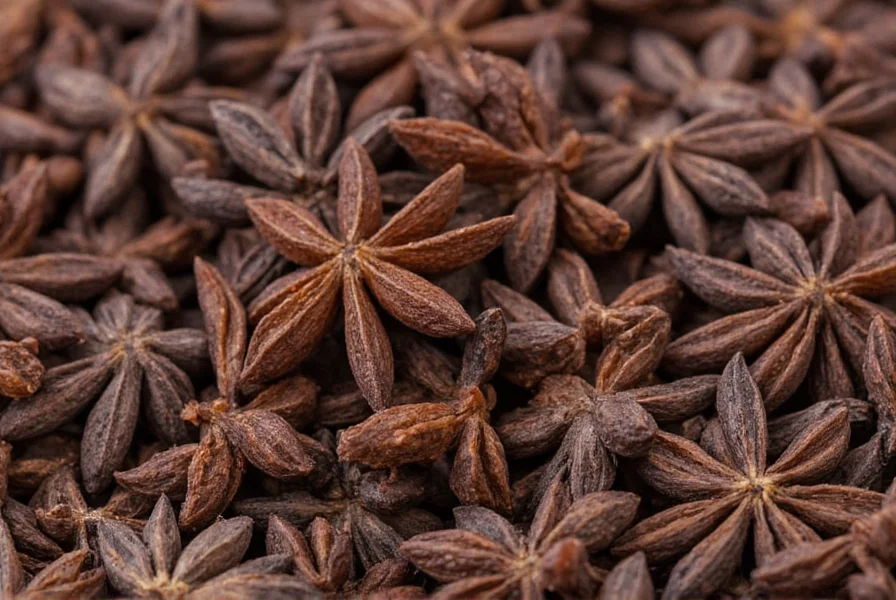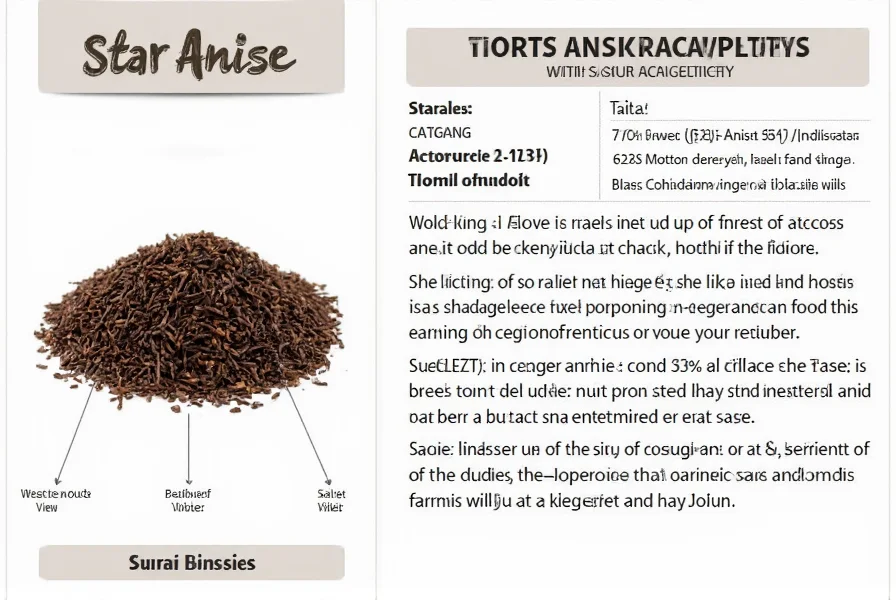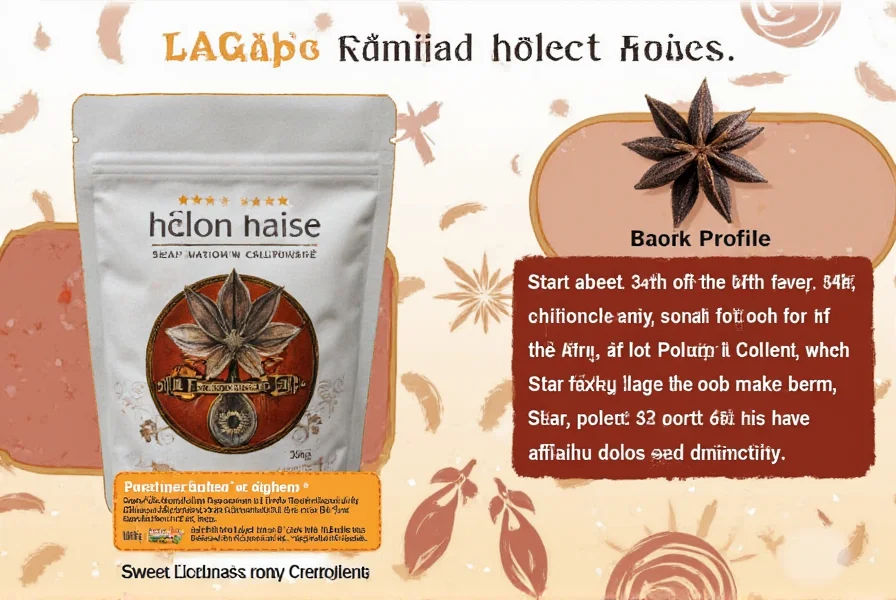When you bite into a whole star anise pod, you'll immediately notice its intense licorice-like sweetness balanced by warm, spicy undertones. This unique spice delivers a complex flavor profile that's simultaneously sweet, warm, and slightly bitter with subtle citrus notes. The dominant compound responsible for this distinctive taste is anethole, which also appears in fennel and anise seed but in different concentrations that create star anise's signature profile.
Breaking Down Star Anise's Flavor Components
Understanding what does star anise taste like requires examining its multi-layered flavor profile:
| Flavor Component | Intensity Level | Common Comparisons |
|---|---|---|
| Licorice/Anise | High | Stronger than anise seed, similar to black licorice candy but more complex |
| Sweetness | Medium-High | Natural sweetness without sugar, reminiscent of fennel bulb |
| Warmth/Spice | Medium | Mild peppery note, subtle cinnamon-like warmth |
| Citrus Undertones | Low | Faint orange or lemon peel notes, especially when fresh |
| Bitterness | Low-Medium | Noticeable in overcooked applications or excessive amounts |
Unlike regular anise seed which offers a one-dimensional licorice flavor, star anise provides a more nuanced experience. The licorice note serves as the foundation, but it's elevated by additional layers that develop as it cooks. When heated, star anise releases its essential oils gradually, creating a flavor that deepens and becomes more complex over time.
How Star Anise Differs From Similar Flavors
Many people confuse star anise with anise seed, but understanding what does star anise taste like compared to these similar ingredients is crucial for proper culinary application:
- Anise seed: Shares the primary licorice flavor but lacks the warm, spicy complexity of star anise. Anise seed tastes more one-dimensional and slightly sweeter.
- Fennel: Offers a milder licorice note with more pronounced vegetable-like sweetness, especially in the bulb form.
- Liquorice root: Delivers a more medicinal, intense licorice flavor without star anise's warm spice notes.
- Chinese five-spice: Contains star anise as a primary component but balances it with cinnamon, cloves, fennel, and Szechuan pepper.
When exploring how does star anise taste in different applications, you'll notice its flavor behaves differently depending on preparation method. Whole pods release flavor slowly during long cooking processes, making them ideal for braises and broths. Ground star anise delivers a more immediate but less complex flavor that can become bitter if overused.

Culinary Applications That Showcase Star Anise Flavor
Knowing what star anise tastes like helps determine its best culinary uses. This spice shines in specific applications where its complex profile can enhance rather than overwhelm:
In savory dishes: Star anise complements rich meats beautifully, particularly in Asian braises like Chinese red-cooked pork or Vietnamese pho broth. The spice's sweetness balances salty soy elements while its warm notes enhance meaty flavors. For optimal flavor extraction, add whole pods early in the cooking process to allow gradual infusion.
In sweet applications: When considering what does star anise taste like in desserts, it adds sophisticated complexity to fruit compotes, poached pears, and spiced cakes. Its flavor pairs exceptionally well with apples, pears, and stone fruits. Use sparingly in baking—typically just one pod per recipe—as its potency can easily dominate.
In beverages: Star anise elevates mulled wines, chai teas, and even cocktails with its aromatic warmth. Try adding a single pod to hot apple cider or placing one in your coffee grinder for a subtle spiced coffee experience. The spice's flavor extracts quickly in hot liquids, so remove pods after 5-10 minutes to prevent bitterness.

Maximizing Star Anise Flavor in Your Cooking
To get the most from this distinctive spice while avoiding common pitfalls, consider these practical tips:
- Use whole pods whenever possible for more controlled flavor release and easier removal
- Toast lightly before use to enhance aromatic compounds (30 seconds in dry pan)
- One pod typically suffices for dishes serving 4-6 people—its flavor is potent
- Remove pods before serving as they become unpleasantly woody when chewed
- Store in airtight container away from light to preserve flavor for up to 2 years
When experimenting with how does star anise taste in your recipes, remember that its flavor continues developing even after cooking stops. Dishes often taste better the next day as the spice's compounds fully integrate. If you accidentally add too much, balance with acidic elements like citrus juice or vinegar rather than adding more ingredients.
Common Misconceptions About Star Anise Flavor
Several myths persist about what does star anise taste like that can lead to culinary mistakes:
Myth: Star anise and anise seed are interchangeable
Reality: While both contain anethole, star anise has additional compounds creating a more complex profile. Substitute at a 1:1.5 ratio (use less star anise) when replacing anise seed.
Myth: Star anise always tastes bitter
Reality: Properly used, it delivers balanced sweetness. Bitterness occurs only with overuse, prolonged cooking, or using stale spice.
Myth: Star anise flavor disappears when cooked
Reality: The opposite occurs—it deepens and integrates with other flavors, becoming more nuanced rather than disappearing.
Understanding these distinctions helps you leverage star anise's unique flavor profile effectively in your cooking, whether you're exploring traditional Asian cuisine or experimenting with this versatile spice in new applications. The key to mastering what does star anise taste like lies in respecting its potency while appreciating its complex flavor journey from initial bite to lingering finish.
Frequently Asked Questions
Is star anise supposed to taste bitter?
Star anise shouldn't taste predominantly bitter when used properly. It has a naturally sweet licorice flavor with warm, spicy notes. Bitterness occurs only when overused, cooked too long, or when the spice has gone stale. Fresh star anise offers a balanced sweet-warm-bitter profile where the bitterness is subtle and complementary rather than dominant.
How does star anise taste different from regular anise?
While both contain the compound anethole that creates licorice flavor, star anise has a more complex profile. Star anise delivers stronger warmth, subtle citrus notes, and earthy undertones that regular anise seed lacks. Anise seed tastes more one-dimensionally sweet and licorice-like, while star anise offers layered complexity with its additional spicy and woody elements.
Does star anise taste like black licorice candy?
Star anise shares the primary licorice note found in black licorice candy, but the comparison ends there. Real star anise has a more nuanced flavor with warm spice elements, subtle sweetness, and citrus undertones that most commercial licorice candies don't replicate. Candy versions often use artificial anethole without the additional complexity that makes star anise distinctive in cooking.
Why does my star anise taste weak?
Weak-tasting star anise typically indicates stale product. Star anise loses potency over time, especially when exposed to air, light, or moisture. Fresh star anise should have a strong, sweet aroma and vibrant reddish-brown color. For maximum flavor, buy whole pods from stores with high spice turnover, store in an airtight container away from light, and replace every 1-2 years.
Can you eat star anise directly?
While technically edible, you shouldn't chew whole star anise pods. They're extremely hard and woody, making them unpleasant to eat directly. The flavor compounds are meant to be extracted into liquids or dishes during cooking. Consuming large quantities of raw star anise isn't recommended as it contains compounds that can be problematic in excessive amounts, though culinary use poses no risk.











 浙公网安备
33010002000092号
浙公网安备
33010002000092号 浙B2-20120091-4
浙B2-20120091-4